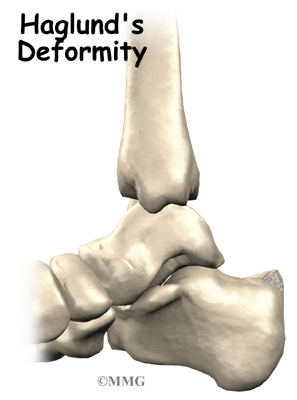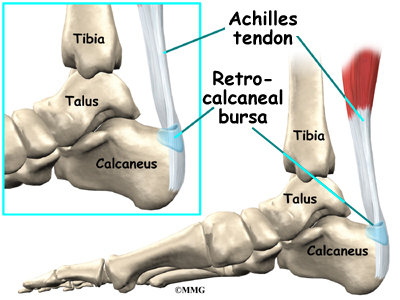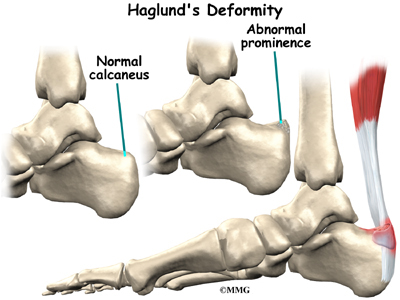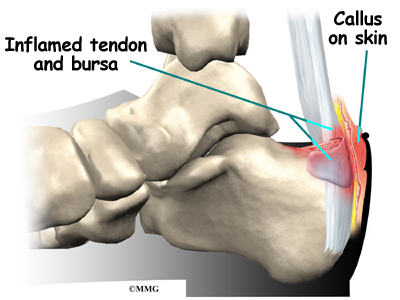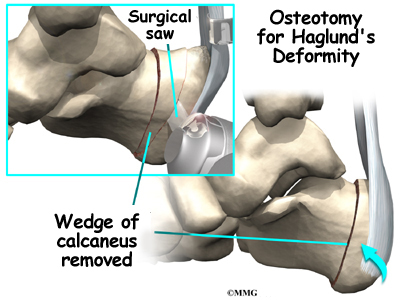A Patient’s Guide to Haglund’s Deformity of the Foot
Introduction
Sometimes the shape of a bone can cause problems in the foot. One example of this is Haglund’s deformity, a condition caused by a prominent bump on the back of the heel.
This guide will help you understand
- where the condition develops
- how it causes problems
- what can be done for your pain
Anatomy
What part of the foot is affected?
The calcaneus (or heelbone) is the largest bone of the foot. The large Achilles tendon attaches to the back of the calcaneus. Between the bone and the Achilles tendon rests a bursa, a lubricated sac of tissue that allows the tendon to slide easily against the bone during movement of the foot. Bursae are found in many places in the body where tissues must move against one another.
Related Document: A Patient’s Guide to Foot Anatomy
Causes
Why do I have this problem?
The primary cause of Haglund’s deformity is pressure on the back of the heel from shoes. The calcaneus is shaped differently in different people. People who have a prominent bump underneath the attachment of the Achilles tendon are more likely to develop Haglund’s deformity. This prominent bump squeezes the soft tissues between the bone and the back of the shoe. Over time, this irritates the soft tissues and causes inflammation. This can cause swelling and thickening of the tissues, which makes the pressure even worse.
Symptoms
What does the condition feel like?
The primary symptom of Haglund’s deformity is pain at the back of the heel. Over time the tissues also usually thicken over the bone bump, causing a callus to form. The callus can grow quite thick and become inflamed while you are wearing shoes. The bursa on the back of the heel can become swollen and inflamed as well, causing bursitis. The bumps do not usually cause any problems with function, such as walking, except for the pain that occurs when the area is inflamed.
Diagnosis
How do doctors identify the problem?
The diagnosis begins with a complete history and physical examination by your surgeon. Usually the condition is quite obvious from the appearance of the back of the heel. X-rays will usually be required to allow the surgeon to see how the calcaneus is shaped and to make sure there is no other cause for your heel pain. Generally no other tests are required.
Treatment
What can be done for a Haglund’s deformity?
Treatment of Haglund’s deformity can be divided into nonsurgical treatment and surgical treatment. In the vast majority of cases, treatment usually begins with nonsurgical measures. Surgery usually is considered when all other measures have failed to control your problem and the pain becomes intolerable.
Nonsurgical Treatment
The primary cause of the problem is shoe wear. The shape of the calcaneus probably would not matter much if we all went barefoot. One easy way to remove the pressure from the back of the heel is to wear shoes with no back, such as clogs. If you must wear shoes with backs, pads placed over the back of the heel may give some relief. Staying out of shoes as much as possible will usually reduce the inflammation and the bursitis due to Haglund’s deformity.
Surgery
Several surgical procedures have been designed to treat Haglund’s deformity. The goal of these procedures is to reduce the prominence on the back of the heel so that the pressure from the shoe does not occur. Over time the thickened tissues will shrink back to near normal size if the pressure is removed.
Bump Removal
Many surgeons simply remove the bump. This procedure is done through a small incision on the back of the heel. The Achilles tendon is retracted (moved away) so that the surgeon can see the back of the calcaneus. Some bone is then removed, and the calcaneus is shaped and rounded so that the pressure does not occur. The incision is closed with stitches, and you are placed in a bulky bandage to protect the foot while it heals. You may be placed in a splint from the knee to the toes.
Wedge Osteotomy
Another way to accomplish the same thing is to take out a wedge of bone from the calcaneus, shortening it. This is referred to by surgeons as a wedge osteotomy. This procedure is performed much the same as removing the bump.
Rehabilitation
What should I expect following treatment?
Nonsurgical Rehabilitation
Patients with an inflamed and painful Haglund’s deformity may benefit from four to six physical therapy treatments. Your therapist can offer ideas of pads or cushions that help take pressure off the back of the heel. You might get recommendations on shoes that keep pressure off the sore area.
These simple changes to your footwear may allow you to resume normal walking immediately, but you should probably cut back on more vigorous activities for several weeks to allow the inflammation and pain to subside.
Treatments directed to the painful area help control pain and swelling. Examples include ultrasound, moist heat, and soft-tissue massage. Therapy sessions sometimes include iontophoresis, which uses a mild electrical current to push anti-inflammatory medicine to the sore area.
After Surgery
You may require crutches for a few days after surgery. A physical therapist or nurse may teach you how to properly use your crutches.
The incision is protected with a bandage or dressing for about one week after surgery. The stitches are generally removed in 10 to 14 days. However, if your surgeon chose to use sutures that dissolve, you won’t need to have the stitches taken out. You should be released to full activity in about six weeks.
